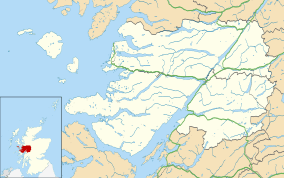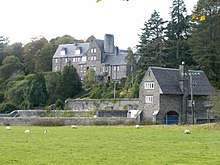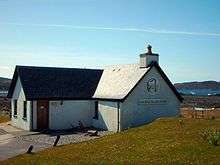Arisaig
Arisaig
| |
|---|---|
 Arisaig Arisaig shown within the Lochaber area | |
| OS grid reference | NM661865 |
| Council area | |
| Country | Scotland |
| Sovereign state | United Kingdom |
| Post town | ARISAIG |
| Postcode district | PH39 |
| Dialling code | 01687 |
| Police | Scottish |
| Fire | Scottish |
| Ambulance | Scottish |
| EU Parliament | Scotland |
| UK Parliament | |
| Scottish Parliament | |
- For the Canadian village, see Arisaig, Nova Scotia.
Arisaig /ˈærəsɪɡ/ (Scottish Gaelic: Àrasaig) is a village in Lochaber, Inverness-shire, on the west coast of the Scottish Highlands, within the Rough Bounds. It is also the traditional name for the part of the surrounding peninsula south of Loch Morar, extending as far east as Moidart. The word Arisaig means "the safe place" in the Scottish Gaelic language. Arisaig is in the Scottish council area of Highland. It has a population of about 300.[1]
History
Early history

Following raids by vikings, Arisaig became part of the Kingdom of the Isles, a Norwegian dependency. In the late 11th century, however, Malcolm III of Scotland made a written agreement with Magnus Barelegs, the Norwegian king, which moved the border to the coast; Arisaig thus became Scottish.
In the early 12th century, Somerled, a Norse-Gael of uncertain origin, came into possession of Arisaig and the surrounding region; no reliable record explains how this happened, but at some point in the 1140s, David I of Scotland's control of the region had been eroded[2]. In the middle of the century, Somerled launched a coup in the Kingdom of the Isles, which resulted in that kingdom joining his other possessions, as a single independent state. Upon Somerled's death, Norwegian authority was restored, but in practice, the kingdom was divided; the portion containing Arisaig was known as Garmoran, and ruled by the MacRory, a faction among Somerled's heirs.
Following the 1266 Treaty of Perth, Garmoran became a Scottish crown dependency - the Lordship of Garmoran - still ruled by the MacRory, until the sole MacRory heir was Amy of Garmoran. Most of the remainder of the Kingdom of the Isles had become the Lordship of the Isles, ruled by the MacDonalds, whose leader, John of Islay, married Amy. After the birth of three sons, he divorced Amy and married the king's niece, in return for a substantial dowry. As part of the arrangement, John deprived his eldest son, Ranald, of the ability to inherit the Lordship of the Isles, in favour of a son by his new wife; as compensation, he made Ranald the Lord of Garmoran.
However, at the end of the 14th century, on Ranald's death, his sons were still children, and Ranald's younger brother Godfrey took the opportunity to seize the Lordship of Garmoran. Furthermore, the heirs of Ranald's other brother Murdoch now made their own claim. This led to a great deal of violent conflict involving Godfrey's family (the Siol Gorrie) and those of his brothers (which is not described in surviving records in much detail).
In 1427, frustrated with the level of violence generally in the highlands, together with the insurrection caused by his own cousin, King James I demanded that highland magnates should attend a meeting at Inverness. On arrival, many of the leaders were seized and imprisoned. Alexander MacGorrie, son of Godfrey, was considered to be one of the two most reprehensible, and after a quick showtrial, was immediately executed[3]. As Alexander had by now inherited Godfrey's de facto position as Lord of Garmoran, and in view of Ranald's heirs being no less responsible for the violence, King James declared the Lordship forfeit.
Lairdship grants

In 1469, James' grandson (James III) granted Lairdship of the lands of Garmoran and Uist to John of Ross, the Lord of the Isles. In turn, John passed it to his own half-brother, Hugh of Sleat; the grant to Hugh was confirmed by the king in a 1493 charter. The violence that led to Alexander's execution had brought the Siol Gorrie to the brink of extinction, and after Alexander's death they played no further part in Arisaig's history[3].
Ranald's heirs (Clan Ranald) disputed and fought against the charter. Following Hugh of Sleat's death, in 1498, and for reasons that are not remotely clear, his son John of Sleat immediately resigned, transferring all authority to the king. By this point, John of Ross's conspiratorial ambition had caused the Lordship of the Isles to be forfeited, but in 1501, his heir, Black Donald, launched an insurrection seeking to restore it. Ranald Bane, leader of Clan Ranald, was one of the few MacDonald-descended clan leaders to refuse to support Donald, so in 1505 (shortly before Donald was defeated) Ranald Bane was given the Lairdship of Arisaig and Eigg, as a reward.
In 1520, the excessive cruelty (not described in detail by surviving records) of Ranald Bane's son, Dougall, led to his assassination, and the exclusion of Ranald Bane's descendants from leadership of Clan Ranald. Instead, Ranald Bane's brother, Alexander, took over the leadership. In 1532, the king provided a charter confirming Alexander's son, John Moidartach, as Laird of Arisaig (and Eigg).
Later history
On 20 September 1746 Bonnie Prince Charlie left Scotland for France from a place near the village following the failure of the Jacobite rising of 1745. The site of his departure is marked by the Prince's Cairn, located at Loch nan Uamh to the east of Arisaig. A few decades later, much of the local population left as well, emigrating to Canada, where in 1785 they founded Arisaig, Nova Scotia.

Arisaig House, the only Scottish country house designed by architect Philip Webb (1831–1915), was built in 1863 for Francis Dukinfield Palmer-Astley (1825–1868). It is situated on the south side of the A830 Lochailort-Morar Road, 3.5km (2.2 miles) south-east of Arisaig, on the north shores of Loch Nan Uamh. The house was largely destroyed by fire in 1935 and remodelled in 1937 for Charlotte Gertrude Astley-Nicholson (died 1961).
In World War II, Arisaig House became the headquarters for the Scottish section of the Special Operations Executive, who ran paramilitary training courses at sites within the surrounding area, to prepare agents for missions in Occupied Europe; the remoteness of the rough bounds made it ideal[4] On 11 November 2009 a memorial to Czech and Slovak soldiers, who trained as SOE agents between 1943 and 1945, was unveiled in Arisaig.[5]
Amenities and attractions

Arisaig has a post office, general store, restaurant, cafe, hotel with bar, and marina. Tourism is the main industry in the Arisaig area.
The Land, Sea and Islands Centre[6] in the village has a display on the connection between the SOE and Arisaig.[7], and Arisaig house itself is now a country hotel.
Famous resident
- Alasdair Mac Mhaighstir Alasdair, the Scottish Gaelic poet, died here in 1770, and was buried in the village's Roman Catholic cemetery.
Transport
Arisaig lies on the A830, which leads to Mallaig to the north and Fort William to the east. The route, which is also known as the Road to the Isles, has been upgraded from a single to a double-track carriageway. Work was completed in 2008.
The village is served by Arisaig railway station on the West Highland Line, which connects the village to Mallaig and Fort William. It is the most westerly station on the British mainland.
A small passenger ferry sails from Arisaig to the Small Isles of Eigg, Muck and Rùm. The main CalMac service to the Small Isles operates from Mallaig.
Cultural references
Several areas of England have Arisaig as a street name, such as Ouston, County Durham. A fictionalized Ardnish peninsula and Arisaig provide the setting for most of the "Ian and Sovra" series of children's novels by Elinor Lyon.[8]
References
- ↑ Ach na skia Croft site Retrieved 5 April 2018.
- ↑ MacDonald, IG (2013). Clerics and Clansmen: The Diocese of Argyll between the Twelfth and Sixteenth Centuries. The Northern World: North Europe and the Baltic c. 400–1700 AD. Peoples, Economics and Cultures (series vol. 61). Leiden: Brill. ISBN 978-90-04-18547-0. ISSN 1569-1462. , p. 37; Woolf, A (2004). "The Age of Sea-Kings, 900–1300". In Omand, D. The Argyll Book. Edinburgh: Birlinn. pp. 94&ndash, 109. ISBN 1-84158-253-0. , p. 102.
- 1 2 Gregory, Donald, History of the Western Highlands and Isles of Scotland, from A.D. 1493 to A.D. 1625, with a brief introductory sketch, from A.D. 80 to A.D. 1493, Edinburgh, W. Tait, retrieved 11 May 2012 , p. 65
- ↑ Commando Country, Stuart Allan, National Museums Scotland 2007, ISBN 978-1-905267-14-9
- ↑ "Memorial to Czechoslovak soldiers unveiled in Arisaig, Scotland". The Czech Embassy in London. Retrieved 9 July 2012.
- ↑ Land, Sea and Islands Centre
- ↑ Special Operations Executive: Para-Military Training in Scotland during World War 2, David M Harrison, Land Sea and Islands Centre, Arisaig
- ↑ Obituary in The Telegraph, 22 July 2008 Retrieved 23 March 2017.
External links
| Wikivoyage has a travel guide for Arisaig. |